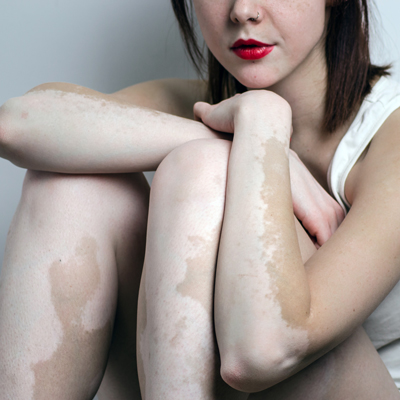Vitiligo
Vitiligo is a medical condition that causes the skin to lose color. Some people develop a few spots that lighten or turn completely white. Others can have widespread loss of skin color. Vitiligo can develop on any part of the body, but commonly begins on the hands, forearms, feet or face. There is no way to predict how much color a person will lose.
Who is at Risk?
Vitiligo affects both genders and all races, but it is more noticeable in people with darker skin. The close “blood relatives” of a patient with vitiligo are also at an elevated risk of developing vitiligo. Patients with vitiligo also have an increased risk of other autoimmune disorders, such as thyroid disease, Type 1 diabetes, rheumatoid arthritis, and others.
Causes
Researchers have discovered that vitiligo develops when cells called melanocytes die or are destroyed by the body’s immune system. As the cells die, an area of the skin or hair turns white because the cells no longer make pigment.
Vitiligo is apparently caused by inheritance of multiple causal genes simultaneously, possibly in different combinations in different people, plus exposure to environmental risk factors or triggers, which are not yet known. Phenols are one example of a suspected environmental trigger. More commonly, stress, whether emotional or physical, can trigger vitiligo. Research continues into these and other possibilities.
Diagnosis
When a dermatologist suspects vitiligo, the practitioner examines the skin. A device called a Wood’s lamp, which shines ultraviolet light onto the skin, may be used to help the dermatologist distinguish vitiligo from other skin conditions.
Depending on your symptoms, blood work may or may not be ordered to see if other associated autoimmune conditions are present.
Treatment
Skin color in vitiligo can occasionally return without treatment.
The first line of treatment in vitiligo is usually topical creams or ointments. If there is no response, other treatments may be considered if they are approved by the patient’s insurance company. There are a number of light and laser treatments for vitiligo, including narrow band UVB, PUVA, or treatment with an ultraviolet Xtrac laser, all of which are available at Brinton Lake Dermatology.
Camouflaging areas of vitiligo with make-up, a self-tanner or dye is sometimes suggested. It is especially important that patients with vitiligo use good sun protection and avoid tanning. The areas of vitiligo will be more visible, if the normal pigmented skin is tan. The areas of vitiligo also have no natural pigment sun protection and are very susceptible to sunburn.

